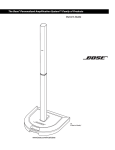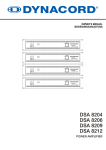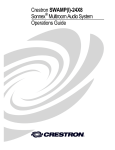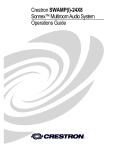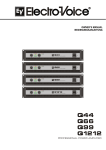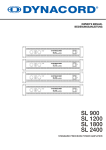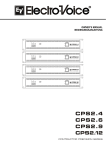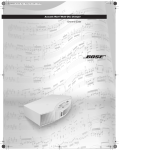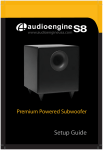Download Bose Personalized Amplification System Specifications
Transcript
The Bose® Personalized Amplification System™ Family of Products Owner’s Guide www.bose.com/musicians Safety Information WARNING: To reduce the risk of fire or electrical shock, do not expose the system to rain or moisture. CAUTION: To prevent electric shock, match the wide blade of the line cord plug to the wide slot of the AC (mains) receptacle. CA AUTION UTION AVI VI S RISK OF ELECTRICAL SHOCK DO NOT OPEN RISQUE DE CHOC ÉLECTRIQUE NE PAS OUVRIR CAUTION: TO REDUCE THE RISK OF ELECTRIC SHOCK, DO NOT REMOVE COVER (OR BACK). NO USER-SERVICABLE PARTS INSIDE. REFER SERVICING TO QUALIFIED PERSONNEL. ATTENTION : POUR RÉDUIRE LE RISQUE DE DÉCHARGE ÉLECTRIQUE, NE RETIREZ PAS LE COUVERCLE (OU L’ARRIÈRE). IL NE SE TROUVE ÀL’INTÉRIEURAUCUNE PIÈCE POUVANT ÊTRE RÉPARÉE PARL’USAGER. S’ADRESSER À UN RÉPARATEUR COMPÉTENT. CAUTION: To reduce the risk of electric shock, do not disassemble this system unless you are qualified. Refer servicing to qualified service personnel. The CAUTION marks shown here are located on the enclosures of your system. These CAUTION marks may be located on the enclosures of the Personalized Amplification System™ PS1 power stand: The lightning flash with arrowhead symbol within an equilateral triangle alerts the user to the presence of uninsulated dangerous voltage within the system enclosure that may be of sufficient magnitude to constitute a risk of electrical shock. The exclamation point within an equilateral triangle, as marked on the system, is intended to alert the user to the presence of important operating and maintenance instructions in this owner’s guide. Additional safety information See the additional safety information on the Important Safety Instructions sheet enclosed with your system. Please read this owner’s guide Please take the time to follow the instructions in this owner’s guide carefully. It will help you set up and operate your system properly and enjoy all of its advanced features. Please save this owner’s guide for future reference. CAUTION: No naked flame sources, such as lighted candles, should be placed on the apparatus. CAUTION: Where the mains plug is used as the disconnect device, such disconnect device shall remain readily operable. ©2003 Bose Corporation. No part of this work may be reproduced, modified, distributed or otherwise used without prior written permission. 2 Important Safety Instructions 1. Read these instructions. 2. Keep these instructions. 3. Heed all warnings. 4. Follow all instructions. 5. Do not use this apparatus near water. 6. Clean only with a dry cloth. 7. Do not block any ventilation openings. Install in accordance with the manufacturer’s instructions. 8. Do not install near any heat sources, such as radiators, heat registers, stoves or other apparatus (including amplifiers) that produce heat. 9. Do not defeat the safety purpose of the polarized or grounding-type plug. A polarized plug has two blades with one wider than the other. A grounding-type plug has two blades and a third grounding prong. The wider blade or third prong are provided for your safety. If the provided plug does not fit into your outlet, consult an electrician for replacement of the obsolete outlet. 10. Protect the power cord from being walked on or pinched, particularly at plugs, convenience receptacles, and the point where they exit from the apparatus. 11. Only use attachments/accessories specified by the manufacturer. 12. Use only with the cart, stand, tripod, bracket or table specified by the manufacturer or sold with the apparatus. When a cart is used, use caution when moving the cart/apparatus combination to avoid injury from tip-over. 13. Unplug this apparatus during lightning storms or when unused for long periods of time. 14. Refer all servicing to qualified service personnel. Servicing is required when the apparatus has been damaged in any way, such as power-supply cord or plug is damaged, liquid has been spilled or objects have fallen into the apparatus, the apparatus has been exposed to rain or moisture, does not operate normally, or has been dropped. Information about products that generate electrical noise This equipment has been tested and found to comply with the limits for a Class A digital device, pursuant to Part 15 of the FCC rules. These limits are designed to provide reasonable protection against harmful interference in a commercial environment. This equipment generates, uses, and can radiate radio frequency energy and, if not installed and used in accordance with the instructions, may cause harmful interference to radio communications. Operation of this equipment in a residential area is likely to cause harmful interference in which case the user will be required to correct the interference at his own expense. This product complies with the Canadian ICES-003 Class A specifications. 15. To prevent risk of fire or electric shock, avoid overloading wall outlets, extension cords, or integral convenience receptacles. 16. Do not let objects or liquids enter the product – as they may touch dangerous voltage points or shortout parts that could result in a fire or electric shock. 17. See product enclosure bottom for safety related markings. 18. Use Proper Power Sources – Plug the product into a proper power source, as described in the operating instructions or as marked on the product. 3 Important Safety Instructions 19. Avoid Power Lines – Use extreme care when installing an outside antenna system to keep from touching power lines or circuits, as contact with them may be fatal. Do not install external antennas near overhead power lines or other electric light or power circuits, nor where an antenna can fall into such circuits or power lines. 20. Ground All Outdoor Antennas – If an external antenna or cable system is connected to this product, be sure the antenna or cable system is grounded. This will provide some protection against voltage surges and built-up static charges. Section 810 of the National Electrical Code ANSI/ NFPA No. 70 provides informaiton with respect to proper grounding of the mast and supporting structure, grounding of the lead-in wire to an antenna discharge unit, size of grounding conductors, location of antenna-discharge unit, connection to grounding electrodes, and requirements for the ground electrode. Refer to the antenna grounding illustration on this page. Antenna grounding Example of antenna grounding as per National Electrical Code, ANSI/NFPA 70. Antenna lead-in wire Ground clamp Electric service equipment Antenna discharge unit (NEC Section 810-20) Grounding conductors (NEC Section 810-21) Ground clamps Power service grounding electrode system (NEC ART 250, Part H) Note to CATV system installer This reminder is provided to call the CATV system installer’s attention to Article 820-40 of the NEC (of USA) that provides guidelines for proper grounding. In particular, it specifies that the cable ground shall be connected to the grounding system of the building, as close to the point of cable entry as is practical. 4 Contents Where to find... Setup . . . . . . . . . . . . . . . . . . . . . . . . . . . . . . . . . . . . . . . . . . . . . . . . . . . . . . . . . . . . . . . . . . . . . . . . Before you begin . . . . . . . . . . . . . . . . . . . . . . . . . . . . . . . . . . . . . . . . . . . . . . . . . . . . . . . . . . . Unpacking . . . . . . . . . . . . . . . . . . . . . . . . . . . . . . . . . . . . . . . . . . . . . . . . . . . . . . . . . . . . . . . . Placing the product in the right location for your performance . . . . . . . . . . . . . . . . . . . . . . . . Product assembly . . . . . . . . . . . . . . . . . . . . . . . . . . . . . . . . . . . . . . . . . . . . . . . . . . . . . . . . . . . Disassembly . . . . . . . . . . . . . . . . . . . . . . . . . . . . . . . . . . . . . . . . . . . . . . . . . . . . . . . . . . . . . . . Connecting a bass module to the power stand (optional) . . . . . . . . . . . . . . . . . . . . . . . . . . . . Connecting one bass module . . . . . . . . . . . . . . . . . . . . . . . . . . . . . . . . . . . . . . . . . . . . . . Connecting two bass modules . . . . . . . . . . . . . . . . . . . . . . . . . . . . . . . . . . . . . . . . . . . . . Setting up additional power stands for more bass output . . . . . . . . . . . . . . . . . . . . . . . . . . . . Full bass setup . . . . . . . . . . . . . . . . . . . . . . . . . . . . . . . . . . . . . . . . . . . . . . . . . . . . . . . . . . Distributed bass setup . . . . . . . . . . . . . . . . . . . . . . . . . . . . . . . . . . . . . . . . . . . . . . . . . . . . Shared bass setup . . . . . . . . . . . . . . . . . . . . . . . . . . . . . . . . . . . . . . . . . . . . . . . . . . . . . . . 6 6 7 8 9 10 11 11 12 13 13 14 15 Controls, Indicators and Connections . . . . . . . . . . . . . . . . . . . . . . . . . . . . . . . . . . . . . . . . . . . . . . Channel 1/2 connections and controls . . . . . . . . . . . . . . . . . . . . . . . . . . . . . . . . . . . . . . . . . . . Channel 3/4 connections and controls . . . . . . . . . . . . . . . . . . . . . . . . . . . . . . . . . . . . . . . . . . . Power amp patch, bass, remote and AC power connections . . . . . . . . . . . . . . . . . . . . . . . . . Remote control features . . . . . . . . . . . . . . . . . . . . . . . . . . . . . . . . . . . . . . . . . . . . . . . . . . . . . . 16 16 16 17 18 Operating Instructions . . . . . . . . . . . . . . . . . . . . . . . . . . . . . . . . . . . . . . . . . . . . . . . . . . . . . . . . . . Producing individualized sound . . . . . . . . . . . . . . . . . . . . . . . . . . . . . . . . . . . . . . . . . . . . . . . . Using input channels 3 and 4 . . . . . . . . . . . . . . . . . . . . . . . . . . . . . . . . . . . . . . . . . . . . . . . . . . Using an effects processor . . . . . . . . . . . . . . . . . . . . . . . . . . . . . . . . . . . . . . . . . . . . . . . . . . . . 19 19 19 20 Maintaining Your Product . . . . . . . . . . . . . . . . . . . . . . . . . . . . . . . . . . . . . . . . . . . . . . . . . . . . . . . . Troubleshooting . . . . . . . . . . . . . . . . . . . . . . . . . . . . . . . . . . . . . . . . . . . . . . . . . . . . . . . . . . . . Customer Service . . . . . . . . . . . . . . . . . . . . . . . . . . . . . . . . . . . . . . . . . . . . . . . . . . . . . . . . . . . Cleaning your product . . . . . . . . . . . . . . . . . . . . . . . . . . . . . . . . . . . . . . . . . . . . . . . . . . . . . . . Warranty . . . . . . . . . . . . . . . . . . . . . . . . . . . . . . . . . . . . . . . . . . . . . . . . . . . . . . . . . . . . . . . . . . Accessories . . . . . . . . . . . . . . . . . . . . . . . . . . . . . . . . . . . . . . . . . . . . . . . . . . . . . . . . . . . . . . . 21 21 22 22 22 22 Technical Information . . . . . . . . . . . . . . . . . . . . . . . . . . . . . . . . . . . . . . . . . . . . . . . . . . . . . . . . . . . 23 For your records The product serial number is located on the bottom of the power stand. Serial number: ________________________________________________________________ Dealer Name: _________________________________________________________________ Dealer phone: ____________________________ Purchase date: _____________________ Please keep your sales receipt and product registration card together with this owner’s guide. 5 Setup Before you begin Thank you for purchasing one of the Bose® Personalized Amplification System™ family of products. This new revolutionary technology brings the benefits of the intimate acoustic concert to amplified performances. Benefits for musicians • You control the sound - Just as in an unamplified performance, you, and no one else, control the sound. You will no longer wonder how you sound to your fellow musicians or to your audience. • Quick and easy setup - The Personalized Amplification System™ product is carried and set up in minutes, not hours. This frees you from the time-consuming, draining, and frustrating effort required to properly set up conventional sound equipment. • Dramatically improved performance - Performance and enjoyment dramatically improve because you will no longer struggle to hear yourself and the other musicians. Benefits for the audience • Creates excitement and emotion - The enhanced performance of the musicians creates the kind of excitement and emotion that is valued by music lovers more than anything else. • You hear what the audience hears - For the first time, musicians hear what their audiences hear and thus, are unlikely to play at uncomfortable sound levels. • The music is naturally dynamic - The softest to the more intense passages can be heard and enjoyed. • You look better - There is less clutter on the stage and more room. • Sound reproduction unlike before - Audience members report that the clarity and excitement that come from hearing the accurate reproduction of sound from each instrument, and from hearing the sound of each instrument in its position on stage (as opposed to mono or even stereo mix of all instruments) is unlike anything they have heard before in an amplified performance. For more information This owner’s guide provides only basic setup and operating instructions. For more in-depth information on using this system, please vist www.bose.com/musicians on the Internet. 6 Setup Unpacking Your Personalized Amplification System™ product (Figure 1) is delivered to you in two cartons. One carton contains the power stand, power stand AC line cord, remote control, and remote control cable. The other carton contains the Cylindrical Radiator™ loudspeaker. If you purchased the optional Model B1 bass module or the carrying bag for the Model L1 Cylindrical Radiator loudspeaker (Figure 2), they are packaged separately. Figure 1 Top section System components Model R1 remote control Model PS1 power stand Power cord Bottom section Remote control cable (15 ft) (4.6 m) Model L1 Cylindrical Radiator loudspeaker Figure 2 Optional equipment and accessories Model B1 bass module MB1 bass module 4-wire cable (5 ft) (1.5 m) Carrying bag for the Model L1 Cylindrical Radiator loudspeaker 7 Setup Placing the product in the right location for your performance Before you start to assemble this product, it is a good idea to find the best location for it. CAUTION: The completed unit weighs about 60 lb. Moving the completely assembed unit is not recommended. Placing the power stand in the right location is an important step in the process of setting up this product to create your own individualized sound. Determining the best location for your performance depends on several things: size of staging area, number of performers, if you will be sharing the power stand connections. The following guidelines should get you started in setting up for a concert or show. For more information on setting up your Personalized Amplification System™ product to achieve an individualized sound, visit www.bose.com/musicians on the internet. • Place the product at the rearmost part of the performance area or stage. • If possible, position the product behind the performer. • If you are part of a group, avoid crowding together on stage. Allow some distance (ideally 7-8 feet) between you and the line array and another performer. This allows the sound to wrap around performers and reflect off adjacent surfaces of the room, creating a more pleasing room-filling “wide-screen” sound. Figure 3 Wall Placement recommendations OK 3 ft 3 ft 3 ft 3 ft 3 ft Drummer Keyboard Bass Wall Better 5 ft 5 ft 5 ft 5 ft 5 ft Drummer Keyboard Bass Wall Best 7-8 ft 7-8 ft 7-8 ft Keyboard 8 Drummer 7-8 ft 7-8 ft Bass Setup Product assembly 1. Place the power stand on the floor. Place it on a flat, dry, stable surface at the rearmost part of the stage, handle facing forward, behind the performer. 4. Connect the remote control to the power stand. Plug the remote control cable into either end of the remote. Plug the other end into the Remote jack. CAUTION: The completed unit weighs about 60 lb. Moving the completely assembed unit is not recommended. For placement guidelines, see “Placing the product in the right location for your performance” on page 8. 2. Insert the bottom section of the Cylindrical Radiator™ loudspeaker into the power stand. You should hear a soft click when it is properly seated and locked in place. Note: Electrical connections between the power stand and loudspeaker are made automatically as you assemble the product. 5. Place the remote control within reach of your performance position. This will allow you to both hear your performance and to control it directly. 6. Plug in the power stand and turn it on. Plug the female end of the power cord into the AC Mains jack on the power stand. Plug the other end into an AC (mains) receptacle. 3. Mount the top section of the Cylindrical Radiator loudspeaker. Place one foot on the power stand to support your back. Insert the bayonet on the top section into the channel that runs along the back of the bottom section. Lower the top section until it is flush with the top of the bottom section. You should hear a soft click as the top section locks in place. Your Personalized Amplification System™ product is now set up and ready for the addition of other equipment. • See “Connecting a bass module to the power stand (optional)” on page 11. • See “Using an effects processor” on page 20. 9 Setup Disassembly CAUTION: Before disassembly, turn the power off and then remove the AC power cord and all other cables from the power stand. Remove the top loudspeaker section Place one foot on the power stand to support your back. Firmly grasp the top section with one hand. Using your other hand, press the release button with your thumb and remove the top section from bottom section. Remove the bottom loudspeaker section Using your foot, push down on the power stand treadle and lift the bottom loudspeaker section up and out of the power stand. 10 Setup Connecting a bass module to the power stand (optional) The Bass/Amp 3 OUT jack on the power stand can adequately drive one or two Model B1 bass modules. Bass modules can be placed on the floor vertically or horizontally. Up to four modules may be stacked when placed horizontally (Figure 4). CAUTION: Do not connect more than two Model B1 bass modules to the Bass/Amp 3 OUT connector on the power stand. Driving more than two bass modules from the Bass/Amp 3 OUT output will improperly load the amplifier in the power stand resulting in less than full system performance. Figure 4 Recommended bass module orientations Bass modules can be placed vertically or horizontally Modules may be stacked in a column of up to four, maximum Connecting one bass module Insert one end of the bass module 4-wire cable into one of the jacks on the rear panel of the bass module. Insert the other end of the 4-wire cable into the Bass/Amp 3 OUT jack on the power stand connector panel. Figure 5 Installation of one bass loudspeaker To connect, push the plug into the jack and rotate it clockwise to lock it (you will hear a soft click). To Bass/Amp 3 OUT To disconnect, slide back the metal tab on the body of the plug, rotate the plug counterclockwise and pull it out of the jack. 4-wire cable 11 Setup Connecting two bass modules Connect the first bass module to the power stand as shown in “Connecting one bass module” on page 11. Insert one end of the second bass module cable into the unused jack on the rear panel of the first bass module. Insert the other end of the cable into one of the jacks on the rear panel of the second bass module. CAUTION: Do not connect more than two Model B1 bass modules to the Bass/Amp 3 OUT connector on the power stand. Driving more than two bass modules from the Bass/Amp 3 OUT output will improperly load the amplifier in the power stand resulting in less than full system performance. Note: Use only the supplied 4-wire speaker cable to connect bass modules to the power stand. The power stand uses the signals on two of the four wires to automatically sense how many bass modules are connected to it. DO NOT SUBSTITUTE the supplied cable with a 2-wire speaker cable. Figure 6 Installation of two bass modules To Bass/Amp 3 OUT 12 Setup Setting up additional power stands for more bass output If you need more bass output than a single power stand with two bass modules can deliver, there is a solution. You can purchase an additional power stand (without loudspeakers) and use its three amplifier channels to drive up to six more bass modules. The second power stand operates as a slave to your primary power stand. There are three bass configurations: • Full bass • Distributed bass • Shared bass Note: Do not insert a Cylindrical Radiator™ loudspeaker into a power stand when it is being used as a stand-alone amplifier. This automatically switches the outputs of the amplifiers from the control panel jacks (Amp 1 OUT, Amp 2 OUT, and Amp 3 OUT) to the loudspeakers. Full bass setup A full bass configuration (Figure 7) consists of two bass modules connected to a primary (“master”) power stand and six bass modules connected to a “slave” power stand which is driven by the “master” power stand. In a full bass configuration, all eight bass modules are driven by the same level and equalization settings. Because this configuration is abnormally bass-heavy, you may need to adjust the equalization on the remote control to suit your artistic preference. Figure 7 Amp 1 OUT Amp 2 OUT All Amps IN Bass/Amp 3 OUT Bass Line OUT Bass/Amp 3 OUT Full bass block diagram Bass modules Primary power stand Slave power stand 1. Set up your primary power stand using two bass modules. See “Product assembly” on page 9 and “Connecting a bass module to the power stand (optional)” on page 11. 2. Connect all six additional bass modules to the second power stand. Connect two bass modules to the Bass/Amp 3 OUT jack. Connect two bass modules to Amp 1 OUT and two more to Amp 2 OUT. See “Connecting two bass modules” on page 12. 3. Group all bass modules together. They can be stacked as shown in Figure 6. 4. Using a typical ¼-inch phone plug connection cable (guitar cable), connect the Bass Line OUT jack on your primary power stand to the All Amps IN jack on the second power stand. 13 Setup Distributed bass setup A distributed bass configuration (Figure 8) can be created by using each of the three power stand amplifiers individually to drive additional bass modules for different performers. For example, let’s say you are a member of an ensemble that includes bass guitar, drums, and a keyboard and all members have a full (optional bass module included) Personalized Amplification System™ unit. When the ensemble plays in louder clubs or larger performance spaces, a bigger sound is needed. The drummer wants more kick drum impact, the bass player wants a little more level on the lower octaves, and the keyboard player needs more low end capability for that pipe organ patch used at the end of the show. Adding a stand-alone power stand enables you to provide separate bass for each performer in order to better preserve the localization of each instrument. Figure 8 Bass 14 Drums Slave power stand Bass Line OUT Bass/Amp 3 OUT Amp 2 OUT Amp 2 IN Amp 3 IN Bass/Amp 3 OUT Amp 1 IN Amp 1 OUT Bass/Amp 3 OUT Bass Line OUT Bass/Amp 3 OUT Bass Line OUT Distributed bass block diagram Keyboard 1. Connect the Bass Line OUT of the drummer’s power stand to the Amp 1 IN on the slave power stand. Place an additional pair of bass modules near the bass modules connected to the drummer’s power stand and connect the Amp 1 OUT of the slave power stand to the additional bass modules. 2. Connect the Bass Line OUT of the bass player’s power stand to the Amp 3 IN on the slave power stand. Place an additional pair of bass modules near the bass modules connected to the bass player’s power stand and connect the Bass/Amp 3 OUT of the slave power stand to the additional bass modules. 3. Connect the Bass Line OUT of the keyboard player’s power stand to the Amp 2 IN on the slave power stand. Place an additional pair of bass modules near the bass modules connected to the keyboard player’s power stand and connect the Amp 2 OUT of the slave power stand to the additional bass modules. Setup Shared bass setup In a shared bass configuration (Figure 9), the musicians can use all the available bass power. Based on the previous example, a shared bass configuration could be set up for the bass player and the drummer. This involves inputting the drums and bass to the master power stand on channels 1 and 2 and driving a full base configuration with a second power stand. You may want to select an appropriate preset for input channels 1 and 2, or set up an external mixer for drums if more elaborate mixing is needed. The primary power stand would be placed somewhere between the bass player and the drummer and the bass would sit somewhere near all this and the primary power stand’s two bass modules. The Cylindrical Radiator™ loudspeaker would distribute the upper harmonics of the bass and drums. This shared configuration would use eight bass modules and be quite suitable for very aggressive playing in night clubs and moderate concerts for up to 200 people. Figure 9 Amp 1 OUT Amp 2 OUT Bass/Amp 3 OUT All Amps IN Ch 2 Input Ch 1 Input Bass Line OUT Bass/Amp 3 OUT Shared bass block diagram Bass modules Primary power stand Drum mixer Slave power stand Bass guitar preamp or direct box 1. Set up your primary power stand using two bass modules. See “Product assembly” on page 9 and “Connecting a bass module to the power stand (optional)” on page 11. 2. Connect all six additional bass modules to the second power stand. Connect two bass modules each to the Amp 1 OUT, Amp 2 OUT, and Bass/Amp 3 OUT jacks. See “Connecting two bass modules” on page 12. 3. Group the bass modules together. They can be stacked as shown in Figure 6 (page 12). 4. Using a typical ¼-inch phone plug connection cable (guitar cable), connect the Bass Line OUT jack on your primary power stand to the All Amps IN jack on the second power stand. 5. Connect the bass guitar to the Channel 1 Input jack. 6. Connect the drum mixer to the Channel 2 Input jack. 7. Select an appropriate preset for channels 1 and 2. 15 Controls, Indicators, and Connections Channel 1/2 connections and controls Unbal Unbal Input ..........................................Combination XLR (mic) or ¼-inch TRS (Line) input jack. Inserting a male XLR connector sends the input signal to a balanced microphone preamplifier. Inserting a ¼-inch phone connector sends the input signal to an unbalanced highimpedance line-level circuit which is suitable for most instruments such as active or passive guitars or basses, keyboards, etc. Both inputs can be adjusted with the Trim control. Mic Trim 0 to 12 ........................Controls the microphone input level. Signal/OL ..................................Indicates signal presence (green) or signal overload (red). Phantom Off/+24V ....................When depressed turns on the +24V phantom power. The LED lights when phantom power is on. Preset Select ............................Selects a comprehensive channel equalization, which results in a “normal” or useful sound when the product is used with commonly available equipment such as microphones, musical instruments or sound processors. The selectable settings from 00 to 99 apply only to channel and 2. Settings are identical on both channels but are independently selected. See the Presets Guide included in the power stand carton. Line OUT ...................................XLR output for sending to external recording equipment. Insert .........................................A TRS line input/output for connecting to external equipment. Plug inserted halfway connects to “Send”; inserted fully connects to “Return”. Note: Use a stereo plug in the Insert jack for connecting send and return signals. Channel 3/4 connections and controls Line IN .......................................A ¼-inch phone connector line input for external equipment. Level 0 to 12..............................Controls the source input level. 16 Controls, Indicators and Connections Power amp patch, bass, remote and AC power connections TRS Bal/Unbal ® Commercial Audio Product 917D Used only when a Cylindrical Radiator™ loudspeaker is NOT installed in the power stand. Amp 1 IN....................................Amplifier 1 input jack. Amp 2 IN....................................Amplifier 2 input jack. Amp 3 IN....................................Amplifier 3 input jack. All Amps IN ...............................Input jack to all amplifiers. Amp 1 OUT................................Amplifier 1 output jack. Amp 2 OUT................................Amplifier 2 output jack. Bass/Amp 3 OUT ......................Bass output (amplifier 3 output) jack. Used to drive one or two Model B1 bass modules. Bass - Line OUT .......................Bass signal output for driving a second power stand used in an extended bass configuration. Data IN ......................................Digital data input. Used for updating product software. Data OUT ..................................Channel 1/2 digital output. Remote......................................Input connection for the remote control. AC Mains...................................3-conductor power cord connections. Fuse ...........................................AC power fuse. On/Off........................................Power stand on/off switch. 17 Controls, Indicators and Connections Remote control features CH 1 CH 2 0 -12 +12 0 -12 -12 +12 0 MID -12 +12 0 -12 0 HIGH 0 LOW +12 +12 -12 +12 LEVEL SIG / OL 0 SIG / OL 0 12 12 MASTER 0 12 CH1/CH2 HIGH -12 to +12 ...............Cuts (-) or boosts (+) high-frequency sounds. CH1/CH2 MID -12 to +12 .................Cuts (-) or boosts (+) mid-frequency sounds. CH1/CH2 LOW -12 to +12 ................Cuts (-) or boosts (+) low-frequency sounds. CH1/CH2 LEVEL 0 to 12...................Adjusts the channel’s volume level. MASTER 0 to 12................................Adjusts volume level of all channels. 18 Operating Instructions Producing individualized sound This product will produce sound whether it is properly adjusted or not. However, if you take a few moments to follow a simple startup procedure, you can optimize the sound for a superior presentation based on your performance style and preferences. Unless you make big changes in how you perform, this is typically a one-time event. 1. Set all gain and level controls on the power stand and remote to zero (0). 2. Set the Power switch to On. CAUTION: The peak inrush current for the system is approximately 32 amps. If more than one system is plugged into the same AC circuit, make sure you stagger the turn-on times. This can prevent tripping the circuit breaker or blowing the house mains fuse. 3. Plug your microphone or instrument into the channel 1 or 2 Input jack. If phantom power is required for your microphone (condenser or electret/condenser type), depress the Phantom power button. 4. Select a preset for your microphone and/or instrument. 5. Sing or play as loud as you would in a performance while following steps 4 and 5. 6. Adjust the Trim control so that the SIG/OL indicator goes from unlit to green, and finally to occasionally blinking red. Make sure that your instrument is at the highest volume setting that you are planing to use. 7. Adjust the LEVEL control on the remote and make the SIG/OL indicator go from unlit to green, and finally to occasionally blinking red. That’s it! You’re done! When you go to your concert or show: • Use the CH 1/2 LEVEL controls on the remote to adjust the channel 1/2 volume level. • Use the MASTER control on the remote to adjust the volume level of all outputs. • Use the HIGH, MID, and LOW equalization controls on the remote to adjust the timbre of your sound. Initially, keep the remote control close at hand. This allows you to conveniently adjust the volume level when you first start playing. Later, you can move it out of the way or backstage once the system is performing the way you want it to. Using input channels 3 and 4 The channel 3 and 4 inputs are optimized for 0 dB line-level signals, such as the signals from an effects processor, mixer, or CD player. Simply connect the equipment to the power stand and raise the output level using the Channel 3/4 Level control on the rear panel of the power stand. 19 Operating Instructions Using an effects processor Note: Connecting an effects unit requires a cable with a ¼-inch phone plug on each end. 1. Insert the phone plug on one end of your cable half way into the Channel 1 Insert jack. 2. Plug the other end of the cable into your effects unit. 3. Plug the cord coming out of the effects unit into the Channel 3 Line IN jack. 4. Adjust Channel 3 Level for the amount of effect added to Channel 1. Figure 10 Adding Channel 1 effects Effects Send Channel 1 Insert (insert plug half way) Effects Return Channel 3 Line IN (insert plug fully) Effects unit 20 Maintaining Your Product Troubleshooting If you experience problems while using this product, try the following solutions. If you still can’t solve the problem, contact your Bose® dealer or Bose Customer Service to arrange for service. Recommended troubleshooting tools: • Portable voltmeter • Cable tester • XLR and ¼-inch phone plug cables • 4-wire bass module cable • Spare T15AH fuses • Spare AC power cord Problem What to do System is plugged in, power switch is on, but power LED is off. • Make sure you have power at the AC outlet. Try operating a lamp or other equipment from the same AC outlet. • Make sure the power stand’s power cord plug is fully inserted into the AC outlet. • Check the line fuse on the power stand. Power LED is on, but no sound. • Make sure volume control is turned up on your instrument. • Make sure the applicable level control is turned up (Trim, or Channel 3/4 Level on the power stand; CH 1/2 LEVEL and MASTER level on the remote). • Make sure your instrument is plugged into the Channel 1/2 Input or Channel 3/4 Input jack. • Connect your instrument to the power stand using a different cable. • Plug your instrument into a different amplifier to make sure the instrument is working. House circuit breaker keeps tripping. • If you have more than one power stand plugged into the same AC circuit, stagger the turn-on times. Each power stand has an inrush current of 32A when turned on. • If you have more than three power stands plugged into a single 15 amp circuit, move some systems to another AC circuit. Each power stand can draw 5 amps or more when playing at high volumes for long periods of time. Bass module is plugged in, • Make sure you are using the 4-wire bass module cable included with the bass module. but no bass is being heard. • Make sure that the bass module cable is plugged into the Bass/Amp 3 OUT jack on the power stand. • Try a different 4-wire bass module cable. • If available, try a different bass module. No mid/high sounds heard from the line array. • Make sure line arrays are firmly seated in their connectors. • Make sure connections are not bent or broken. • Try cleaning the contacts on the line arrays with electronic contact spray cleaner. Microphone sounds distorted. • Make sure the red clip light is not constantly on. If it is, lower the trim. • Try a different microphone. • Try your microphone on another power stand. One of the four instruments plugged into the power stand is at a lower volume than the others. • If the instrument is plugged into channel 3/4, use a direct box or high-to-low transformer (high impedance instruments, such as non-active guitars or basses, are not designed to be plugged directly into a low impedance input). • If the instrument’s volume is still lower than the others, try a similar instrument in the same channel. If this solves the problem, your instrument may not be working correctly. 21 Maintaining Your Product Problem What to do When using the Insert jack as a send to an effects unit, you hear only effect and no dry signal. • Make sure the ¼-inch plug is inserted only half way into the jack (first click). When the plug is inserted all the way, it breaks the signal to the power amp and sends all of the signal to the effects unit. The remote is not working. • Make sure the remote cable connector is firmly seated into the jack on the remote and the power stand. • Try a different 7-pin midi cable. Customer Service For additional help in solving problems, contact Bose® Customer Service. Cleaning your product • You may clean the product enclosures using only a soft dry cloth. • Do not use any solvents, chemicals, or cleaning solutions containing alcohol, ammonia or abrasives. • Do not use any sprays near the product or allow liquids to spill into any openings. • If necessary, you may carefully vacuum the grille assembly of the line source Warranty Your Personalized Amplification System™ product is covered by a limited transferable warranty. Details of the warranty are provided on the product registration card that came with your product. Please fill out the information section on the card and mail it to Bose Corporation. Accessories Carrying bag for the Cylindrical Radiator™ loudspeaker Power stand cover 22 Technical Information Mechanical Dimensions • Power stand: 26.0 in (660 mm) W x 26.0 in (660 mm) D x 5.0 in (127 mm) H • Cylindrical Radiator™ loudspeaker (each section): 3.5 in (89 mm) W x 4.0 in (105 mm) D x 43.0 in (1092 mm) H • Remote control: 2.8 in (71 mm) W x 5.6 in (141 mm) D x 1.6 in (40 mm) H • Bass module (optional): 10.3 in (250 mm) W x 18.0 in (457 mm) D x 15.3 in (380 mm) H Weight • Power stand: 35 lb (16 kg) • Lower line array: 16.0 lb (7 kg) • Upper line array: 14.5 lb (6 kg) • Remote control: 0.6 lb (0.27 kg) • Bass module (optional): 28 (13 kg) Electrical Impedance • Cylindrical Radiator loudspeaker: 4 Ω • Bass module (optional): 8 Ω AC power rating • USA/Canada: 100-127V 50/60 Hz 1400W • Peak inrush current: 32A @ 120V 60 Hz 23 ©2003 Bose Corporation, The Mountain, Framingham, MA 01701-9168 USA 263976 AM Rev.00 JN30987 www.bose.com/musicians
























